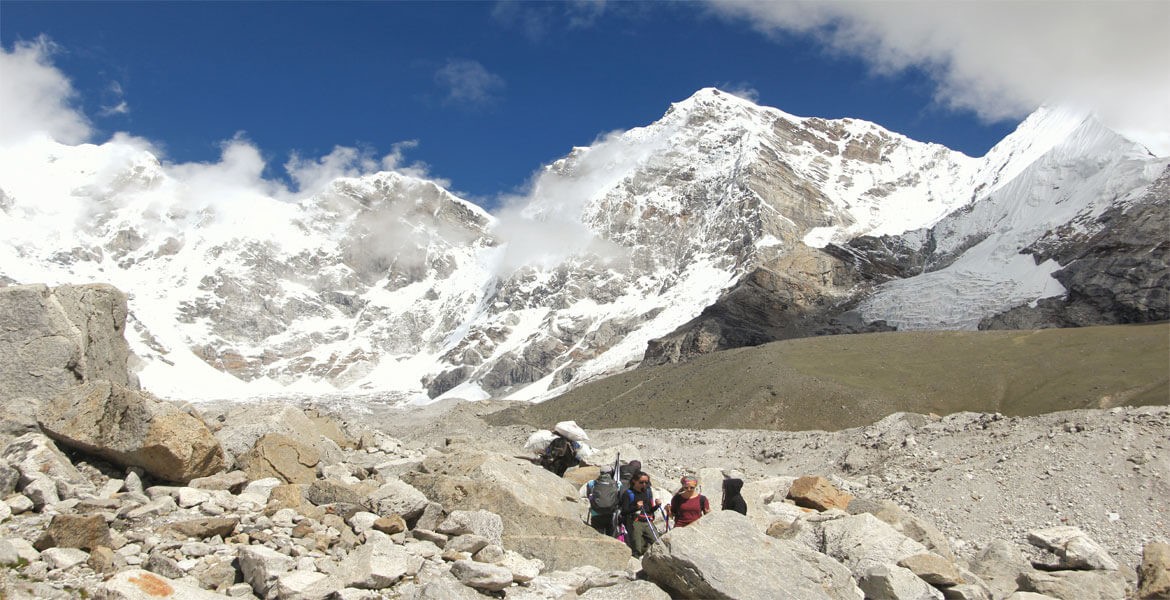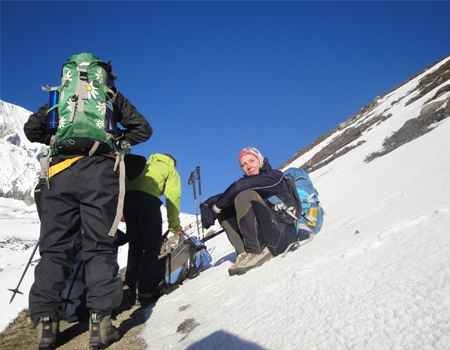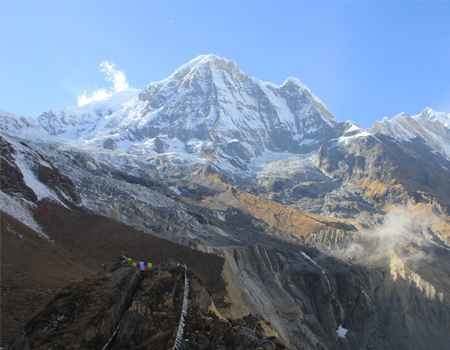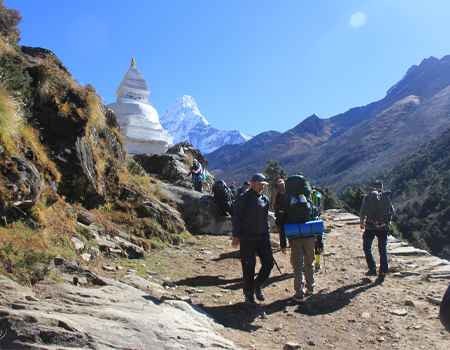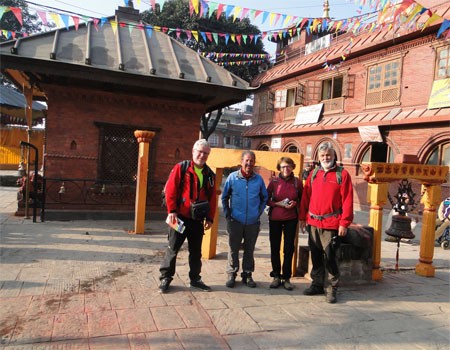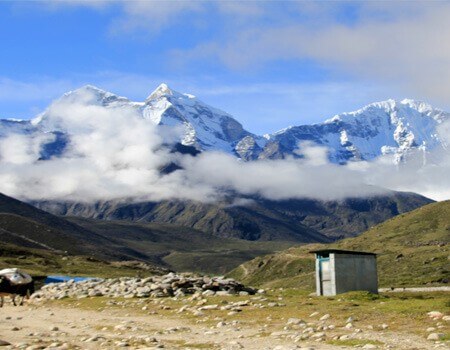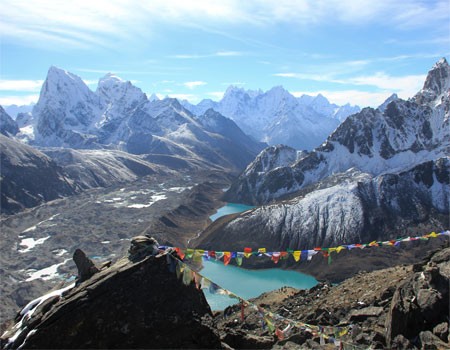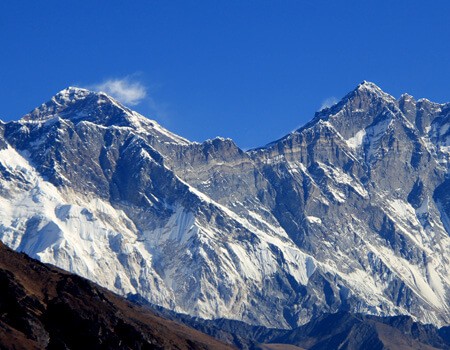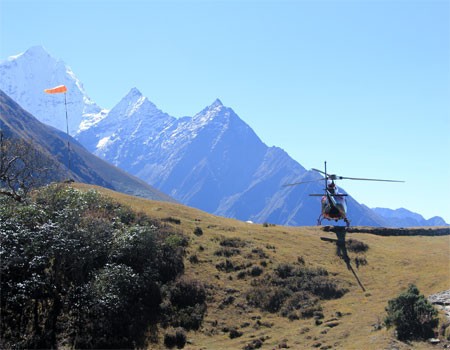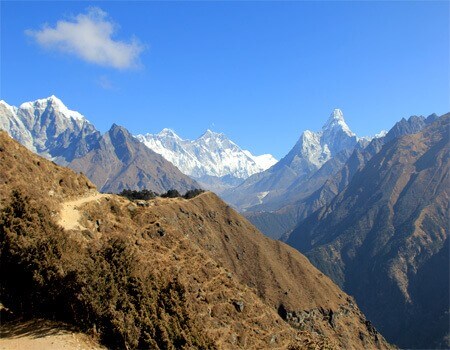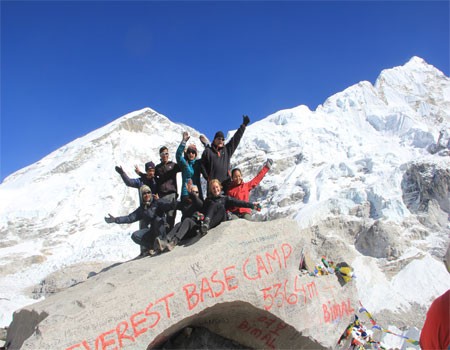March marks the beginning of spring in Nepal, bringing new life to the Himalayas and the Everest Region. Temperatures rise every day, and snow starts melting this month. The Everest Region will have clear mountain views, blooming forests, and a vibrant atmosphere teeming with adventure this season. Spring is widely recognized as the second busiest trekking month in Nepal, as March falls within this season, making it a favored period for the iconic Everest Base Camp trek.
Why Choose March for Your Trek?
- Beginning of Spring: As spring arrives in March, the temperature begins to warm up, making trekkers more comfortable walking and staying in the higher elevations.
- Prime Trekking Season: Favourable weather, longer daylight hours, and reduced precipitation create near-perfect trekking conditions.
- Buzzing Trail Life: Spring heralds increased activity, with climbers, trekkers, and friendly locals adding energy to the path.
Everest Base Camp Weather and Temperatures in March
Spring initiates a transition from Kathmandu's warmer valleys to the pristine, brisk heights of the Everest region. By March, winter's harshest grip has loosened. However, trekkers can still experience a blend of conditions, especially in the early part of the month.
- Mornings and Evenings: At the lower trekking start point in Lukla (2,800m), temperatures can drop to around 2°C, especially overnight. Higher up at Base Camp (5,364m), overnight lows can reach -15°C.
- Daytime Warmth: As the sun rises, it warms the environment pleasantly, providing comfortable hiking temperatures during the day.
- Sky Conditions: In early March, lingering haze can be found in valleys, but skies generally clear as you ascend, offering breathtaking blue panoramas and sunlit hillsides.
- Occasional Snow: While the cold lingers, especially in the first week, expect some fresh snowfall in elevated areas and potential hail at lower elevations, usually in the late afternoons.
We have provided detailed information on the weather and temperature of Everest Base Camp Trek in our other blog post.
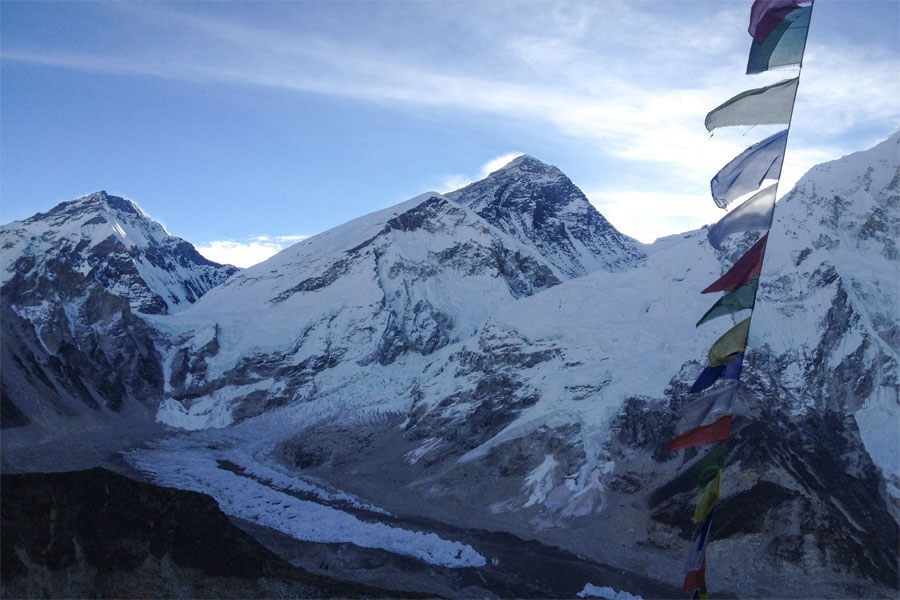
Kalapatthar (5,545m)
Everest Base Camp March Highlights
March is vibrant on the Everest trail. Here's what makes it special:
Khumbu Glacier
One of Everest's crowning features, the Khumbu Glacier, stretches dramatically from over 4,400 meters to nearly 7,000 meters. In March, the combination of ice and rock offers both visual grandeur and intrigue, forming a massive frozen river framed by snowy peaks.
Meeting Everest Climbers
Spring is the primary climbing season for Everest. In March, Base Camp turns into a bustling village, with hundreds of climbers and their vibrant campsites. Trekking at this time lets you rub shoulders with adventurers from across the globe, many of whom are preparing for their summit push.
Lush Valleys and Rhododendron Blooms
As you progress from Phakding to Namche, Tengboche, and beyond, you'll traverse valleys that change character with altitude. The lower Dudhkoshi valley is rich with forests, which come alive with blooming rhododendrons—Nepal's national flower—and other wildflowers in March. Higher valleys such as Imja and Khumbu offer open vistas of snow-capped mountains towering above the treeline.
Epic Views of the Icefall and Kalapatthar
The infamous Khumbu Icefall sparkles in March, made even more impressive under clear spring skies. Ascending Kalapatthar (5,545m) offers unmatched panoramic views of the Everest massif and the vast glacier below, possibly even more awe-inspiring as climbers' tents fill the landscape.
Connecting with Other Trekkers
March's popularity as a trekking month means you'll meet travelers from many countries. The camaraderie and shared adventure foster friendships, as well as the chance to swap stories along the trail or in teahouse lodges.
Rewards of Trekking Everest Base Camp in March
Clear Weather: March is famed for crystal-clear days, offering truly spectacular visibility with the Himalayas gleaming under the sun.
Blooming Forests: From rhododendrons to magnolias, the foothills burst with color, transforming the trekking route into a scenic wonderland.
Reduced Flight Cancellations: Stable weather means flights to Lukla are less likely to be delayed or cancelled, minimizing frustrating travel interruptions.
Vibrant Base Camp Atmosphere: The base camp becomes a lively hub, with colorful tents, international climbing teams, and nighttime lantern glows creating an almost 'mini city' feel.
Friendly Trail Communities: The trail's traffic at this time is social and spirited, providing plenty of opportunities to interact, exchange advice, and join impromptu trekking groups.
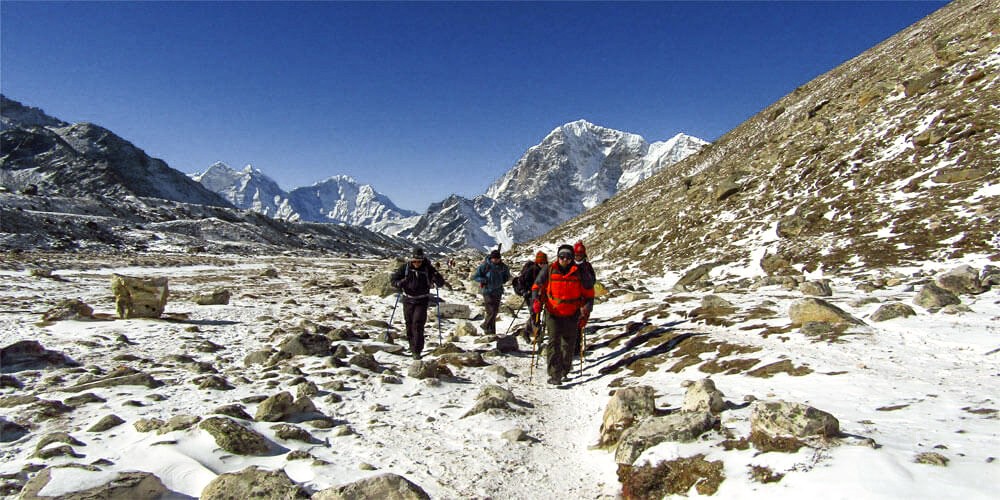 Trekkers on the Everest trail
Trekkers on the Everest trail
Challenges of Trekking Everest Base Camp in March
Despite the many rewards, trekkers should be aware of specific seasonal challenges:
Flight Availability to Lukla
March's popularity can make flights to Lukla difficult to secure at short notice. Booking is strongly recommended to avoid disappointment, as tickets often sell out weeks or even months in advance.
Wind and Dust
The latter part of March can bring windy afternoons, especially in exposed sections of the trail. Wind may contribute to Lukla flight delays and kick up dust along the path, making a buff or face mask essential.
Occasional Snow and Hail
Snowfall remains possible in the higher altitudes, especially early in the month. Hail and sudden weather changes can also occur lower on the trail, generally in the late afternoons.
Crowded Trails and Accommodation
Hundreds of trekkers traverse the EBC route daily in March. Popular villages such as Tengboche, Lobuche, and Gorakshep often experience full lodges, making reservations for accommodations crucial.
Altitude-Related Difficulties
Steady ascent means dealing with thin air as you climb. Altitude sickness—characterized by headaches, dizziness, or nausea—is a risk and should be taken seriously.
Expert Tips for a Successful March Everest Base Camp Trek
- Book Lukla Flights Early: Secure your spot weeks or months ahead to ensure entry into the region during peak trekking periods.
- Start Hikes Early: Kick off treks each morning to minimize the risk of getting caught in afternoon winds or hail. Aim to reach your next lodge by 3 pm.
- Hydrate Well: Drink at least 3L of clean, purified water per day. Supplement with warm beverages to fend off dehydration in cold, dry air.
- Take it Slow: Maintain a comfortable walking pace to help your body acclimate and reduce the risk of altitude sickness.
- Monitor for Symptoms: Be vigilant for signs of altitude sickness and do not ascend further if symptoms develop.
- Book Accommodation Early: Secure accommodation at least a day ahead, especially for remote or limited-lodge settlements.
- Travel in Groups or with a Guide: Local guides and porters offer expertise, safety, and enhanced cultural understanding, especially helpful in busy or high-altitude stretches.
- Carry Local Cash: ATMs and card payments are rare along the trail, so bring sufficient Nepalese rupees for extra provisions or emergencies.
- Night Safety: Stay close to your lodge or camp after dark.
Packing List for March Trekking
- Trekking rucksack or duffel bag
- Comfortable, sturdy daypack
- Warm sleeping bag (rated for -15°C or colder)
- Sun hat and insulated beanie
- UV-protective sunglasses
- Buff or neck gaiter for dust/wind
- Moisturizing cream and lip balm
- Light and thermal trekking shirts (long and short-sleeve)
- Fleece and down jackets
- Windproof trousers; trekking pants (full and half)
- Water-resistant hiking boots and extra comfortable shoes/sandals
- Multiple pairs of warm trekking socks
- Gloves (inner and outer layers)
- Quick-dry towel
- First-aid kit with personal medications
- Trekking poles
- Headlamp, spare batteries, and power bank
- Wet wipes, sanitizer, and basic toiletries
- Multi-plug travel adaptor and charging cables
- NCELL SIM card for local data
- Emergency snacks and hydration tablets
- Waterproof gaiters
The lists above are for general information on packing lists for the Everest Base Camp, but we have other blog posts that provide more detailed information for both males and females. You can read that, which makes it easier for you to manage your packing list.
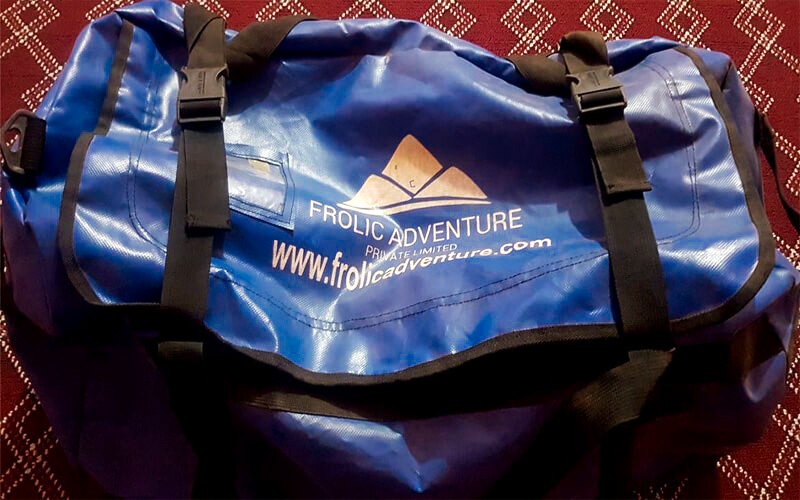
Main bag for the trekking equipment
Alternative Routes in the Everest Region for March
If you prefer solitude or wish to avoid the busiest trails:
Three High Passes Trek: Crosses Kongma La, Cho La, and Renjo La, which can have deep snow early in March, but become more passable later in the month.
Gokyo Valley Trek: Offers dazzling turquoise lakes, dramatic glacier walks, and sweeping mountain views away from the crowds.
Everest View/Panorama Trek: Ideal for those short on time or seeking lower altitudes; ascend to Tengboche for incredible Everest vistas without the rigors of reaching base camp.
Short Everest Base Camp Trek in March
Pressed for time or looking for a unique itinerary? Opt for a condensed EBC trek, typically completed in 8–9 days, which includes a return by helicopter from Gorakshep to Kathmandu, allowing for complete immersion on the trek and a bird's-eye perspective on the flight back, thereby maximizing your Himalayan experience.
Suppose you are an adventurous person who regularly treks and hikes to the higher elevations in the Himalayas. In that case, you can complete the Everest Base Camp trip in 10 days from Kathmandu to Kathmandu without taking a helicopter flight.
Booking Your March Everest Base Camp Trek
Frolic Adventure offers both group and private departures in March, with many incentives for early bookings, including discounts. Ensure you work with a reputable operator for proper logistics, trusted guides, and secure payment systems. For solo hikers, established routes and communal lodges enhance safety and camaraderie; however, solo journeys still require planning due to high demand.
Conclusion
Why March is a Once-in-a-Lifetime Trekking Opportunity?
March is the perfect month to immerse yourself in the grandeur of Everest Base Camp. Clear weather, blooming forests, and a vibrant mountaineering community make this season unique. Whether you're an experienced trekker or a first-time Himalayan explorer, the unique spirit of March—crisp air, brilliant mountain views, and exhilarating encounters—promises a journey you'll treasure forever. Prepare well, trek with respect for the mountains, and embrace every moment in this natural wonderland.
